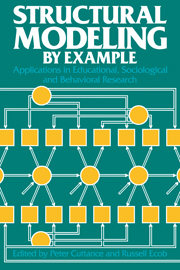Book contents
- Frontmatter
- Contents
- Preface
- List of contributors
- 1 Introduction
- 2 An overview of structural equation modeling
- 3 Field dependence and the differentiation of neurotic syndromes
- 4 High school seniors' reports of parental socioeconomic status: black–white differences
- 5 Modeling the hierarchical structure of learning
- 6 A study of longitudinal causal models comparing gain score analysis with structural equation approaches
- 7 Some structural equation models of sibling resemblance in educational attainment and occupational status
- 8 Applications of structural equation modeling to longitudinal educational data
- 9 The robustness of maximum likelihood estimation in structural equation models
- 10 An inquiry into the effects of outliers on estimates of a structural equation model of basic skills assessment
- 11 Testing structural equation models
- 12 LISREL models for inequality constraints in factor and regression analysis
- 13 Issues and problems in the application of structural equation models
- Appendix
- Glossary
- Index
4 - High school seniors' reports of parental socioeconomic status: black–white differences
Published online by Cambridge University Press: 12 January 2010
- Frontmatter
- Contents
- Preface
- List of contributors
- 1 Introduction
- 2 An overview of structural equation modeling
- 3 Field dependence and the differentiation of neurotic syndromes
- 4 High school seniors' reports of parental socioeconomic status: black–white differences
- 5 Modeling the hierarchical structure of learning
- 6 A study of longitudinal causal models comparing gain score analysis with structural equation approaches
- 7 Some structural equation models of sibling resemblance in educational attainment and occupational status
- 8 Applications of structural equation modeling to longitudinal educational data
- 9 The robustness of maximum likelihood estimation in structural equation models
- 10 An inquiry into the effects of outliers on estimates of a structural equation model of basic skills assessment
- 11 Testing structural equation models
- 12 LISREL models for inequality constraints in factor and regression analysis
- 13 Issues and problems in the application of structural equation models
- Appendix
- Glossary
- Index
Summary
Introduction
Measurement error is insidious. It creeps into data collection and analysis in various ways, and its effect on substantive conclusions is more dangerous than is usually appreciated. This chapter investigates one aspect of measurement error – the structure of errors in high school seniors' reports of parental socioeconomic status – and compares the pattern of these reporting errors between blacks and whites.
Models of educational achievement often include measures of socioeconomic background in order to control for socioeconomic differences in assessing the effects of educational treatments. If, however, these background variables have been measured with substantial error, one's substantive conclusions will be affected. For example, if the background variables contain substantial random measurement error, the least squares estimates of their effects on measures of educational outcomes will be less than their true effects, and any assessment of the influence of educational treatments may be correspondingly inflated (Mason et al. 1976). The effects of intervening educational treatments will also be inflated in least squares analyses if the errors of measurement of socioeconomic background variables are correlated across different variables (Bowles 1972). As a result, the correlation among measured background variables will be artificially inflated, and the educational treatment variable will explain more of the variation in the outcome variable than warranted in actuality.
Moreover, when the effects of treatments are estimated across groups, such as blacks and whites, differential amounts and kinds of measurement error among background variables will have differential effects on estimates of the effects of both the background variables and the treatment.
- Type
- Chapter
- Information
- Structural Modeling by ExampleApplications in Educational, Sociological, and Behavioral Research, pp. 51 - 64Publisher: Cambridge University PressPrint publication year: 1988



